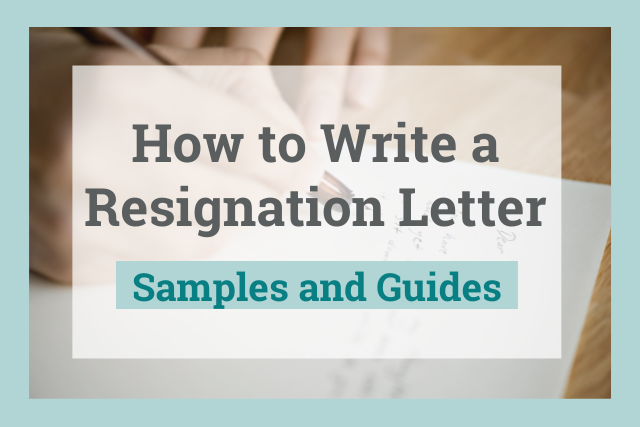
A resignation letter is an official document that notifies your employer of your intention to leave your job. It can take the form of either a printed letter or an email.
You should turn in your resignation letter at least two weeks before your departure date so your employer has time to make preparations (do make sure you check your company's policy on just how much notice you have to give).
How Do You Write a Professional Resignation Letter?
You should write your resignation letter with a professional but positive tone. As a rule of thumb, use the same tone you would use if you planned to come back to the company again in the future.
Leaving on good terms will help your career in the long run. You want to make sure you don’t burn any bridges, especially if you’re leaving due to personal grievances.
Even if you do have personal grievances with the company, your resignation letter is not the right place to mention those. Bring them to HR or discuss them in an exit interview. Your resignation letter is an official document meant primarily for your manager’s eyes.
In general, it’s best to keep the letter short and sweet. One page is enough to tell your boss you’re leaving.
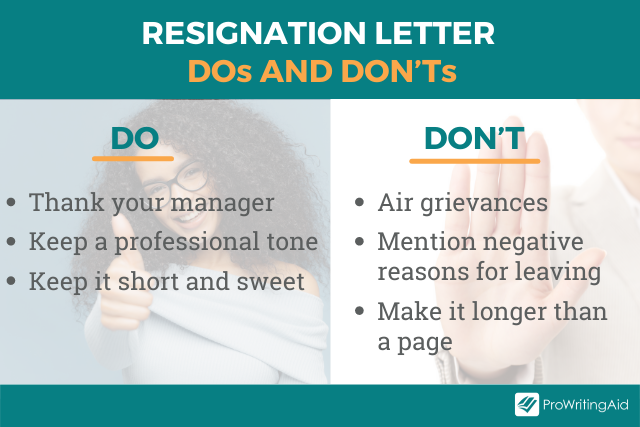
What Do You Need to Include in a Resignation Letter?
There are three steps you should follow to write a resignation letter:
- Step 1: Clearly state your intention to resign
- Step 2: Thank your manager for your time at the company
- Step 3: Offer to help with the transition period
A standard structure for a resignation letter takes the form of three paragraphs. You can use each paragraph to hit one of the steps.
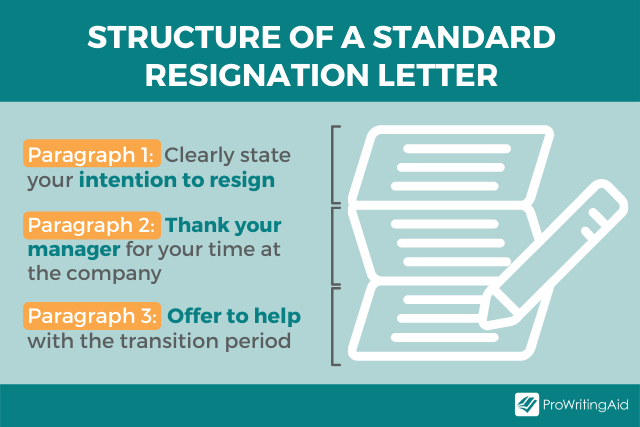
Step 1: Clearly State Your Intention to Resign
Use the first paragraph to announce your official intention of leaving your role with the company. State the exact date you’ll be leaving so there’s no ambiguity.
You don’t have to explain why you’re leaving, especially if the reason is a negative one. Usually, stating your reason will only make a negative impact, and you want to keep things positive.
Here's an example of what your first paragraph could look like:
Please accept this letter as formal notice of my intention to resign from my position as [job title] with [company]. In accordance with my notice period, my final day will be [date of last day].
Step 2: Thank Your Manager for Your Time at the Company
The second paragraph is a great opportunity to mention any positives about your time working with the company. Convey your appreciation for everything your manager and team members have done for you.
You can talk briefly about what you’ve learned and how those skills will help your career going forward. You can also mention what parts of the company culture you’ve enjoyed, or if there’s anything you’ll miss going forward.
If you didn’t have a good experience at this job, you should still use the second paragraph to briefly thank them for this opportunity. A single sentence is fine; you can simply say, “Thank you for giving me the opportunity to grow in this role.”
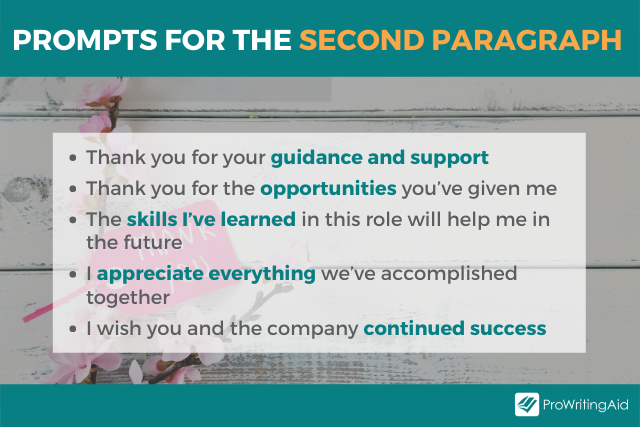
There might be cases in which you want to share the reason you’re leaving. If you have a close working relationship with your manager and you’re excited about the next step—for example, if you’re retiring, going back to school, or taking on an exciting new challenge—you can mention this next step in the second paragraph.
Sharing your next step is nice, but not necessary, and it’s perfectly fine to omit it from your resignation letter.

Here's an example of what your second paragraph could look like:
Working for [company] has been a wonderful experience, and I sincerely appreciate everything we’ve accomplished together. Thank you for the opportunities you gave me to learn from you. Your guidance and support will help me in my future roles.
Step 3: Offer to Help with the Transition Period
Close with an offer to help make the transition process as smooth as possible.
If the company will be hiring someone to replace you within the next two weeks, offer to help train them or hand over your existing duties. You may have client contacts or other data that you’ll need to hand over and explain to them as well.
If you don’t know what the company will do to replace you, you can make a general offer of assistance (“Please let me know how I can be of assistance during the transition period.”)
Here's an example of what your third paragraph could look like:
Please let me know how I can be of assistance during the transition period. I'd be happy to help train my replacement.
What Are Some of the Best Sample Resignation Letters?
We’ve compiled a few sample resignation letters you can use as guides for writing yours. We have samples for the following situations:
- A template for standard transitions
- A template for if you’re leaving for a new challenge
- A template for if you’re retiring
- A template for if you’re leaving immediately
When you write your own letter, feel free to customize these samples to fit your own needs. It's also important to ensure your letter reads well and is grammatically correct.
ProWritingAid’s Style Report can help you set the right tone, improve readability, and leave a great last impression.
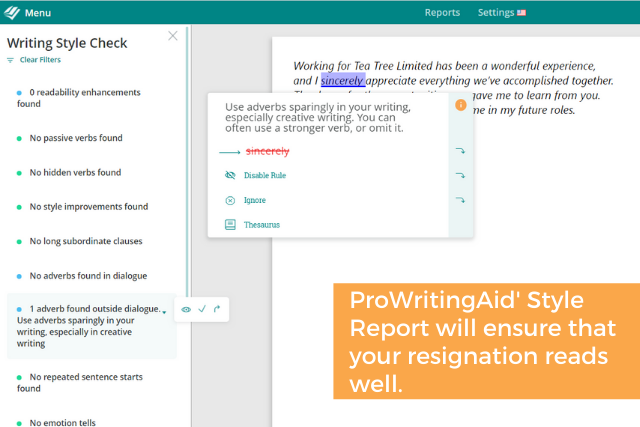
Try the Style Report with a free ProWritingAid account.
Standard Resignation Letter Template
Here’s a standard resignation letter sample that will work for any kind of transition. The standard is to keep the letter short and sweet.
Dear [supervisor’s name],
Please accept this letter as formal notice of my intention to resign from my position as [job title] with [company name]. In accordance with my notice period, my final day will be [date of last day].
I’d like to thank you for the opportunities you’ve given me while working here. Your guidance and support will help me in my future roles.
Please let me know how I can be of assistance during the transition period. I wish you and the company the best going forward.
Sincerely,
[Your name]
Resignation Letter Template for if You’re Leaving for a New Challenge
Here’s a more personalized resignation letter sample you can use if you’re leaving for a new role and you see your supervisor as a mentor who wants the best for your career.
In this case, it’s alright to give more detail about the reason you’re leaving, since it’s a positive rather than a negative one.
Dear [supervisor’s name],
Please accept this letter as my formal resignation from my position as [job title] at [company name], effective two weeks from today, [current date].
After a period of careful consideration, I have decided to [reason for leaving]. After [number of years] of [something you accomplished in your current role], I am ready to take the next step forward by transitioning to [new level of responsibility].
Working for [company] has been a wonderful experience. Thank you for the opportunities you gave me to learn from you.
If you need any help training my replacement, I’d be happy to help with the transition. It’s been a privilege to work with you, and I hope we have the opportunity to collaborate again in the future.
Sincerely,
[Your name]
Resignation Letter Template for if You’re Retiring
Here’s a resignation letter sample you can use if you’re leaving for retirement, and you’ve been with this company for a considerable amount of time.
Dear [supervisor’s name],
I am writing to inform you that I will be formally retiring effective [resignation date].
After a period of careful consideration, I have decided that this is the right time for me to take this step.
I am proud to have achieved so much with [company] over these past [number of years] years. I sincerely appreciate everything we’ve accomplished together. I will miss all of my colleagues here, and I wish the company continued success.
Please let me know if there’s any additional assistance I can provide to enable a smooth transition.
Sincerely,
[Your name]
Resignation Letter Template for if You’re Leaving Immediately
If you absolutely need to leave immediately and can’t put in your two weeks’ notice, here’s a resignation letter sample that announces an immediate departure.
Dear [supervisor’s name],
Please accept this letter as my formal resignation from my position at [company name], effective immediately.
I sincerely apologize for my abrupt departure. However, due to unforeseen circumstances, I have decided to resign today.
Thank you for the great opportunities to build skills in numerous areas here. I appreciate the opportunity to work with you.
Please let me know if there’s anything I can do to make my departure easier. I wish you and the company the very best going forward.
Sincerely,
[Your name]
How Do You Format a Professional Resignation Letter?
The simple answer is that you should use the same letter formatting you would use for any professional letter.
- Choose a professional font, such as Times New Roman, Arial, or Calibri.
- Keep your font size readable: 11pt or 12pt is ideal.
It’s best practice to include your current contact information, such as your cell-phone number, your address, and your non-work email.
Some of your formatting will depend on whether you decide to resign with a physical letter or with an email.
Formatting Physical Resignation Letters
If you’re handing in a physical letter, single space your letter, with 1-inch margins all around.
You should use a center-aligned header with your name and address.
Follow with a left-aligned header with the current date, your manager’s name, the company name, and the company address.
Here’s an example:
[Your name] [Your address][Current date]
[Manager’s name]
[Company name]
[Company address]
Sign off with a written signature, followed by your full name.

Formatting Emailed Resignation Letters
If you’re resigning by email, use the subject line: “Letter of resignation — [Your Name].” That way, the purpose of the email is clear.
Your typical email signature is fine, though you can also include a digital signature if you wish.
Here’s an example:
To: [Manager’s Email]
From: [Your name]
Subject line: Letter of resignation — [Your Name]
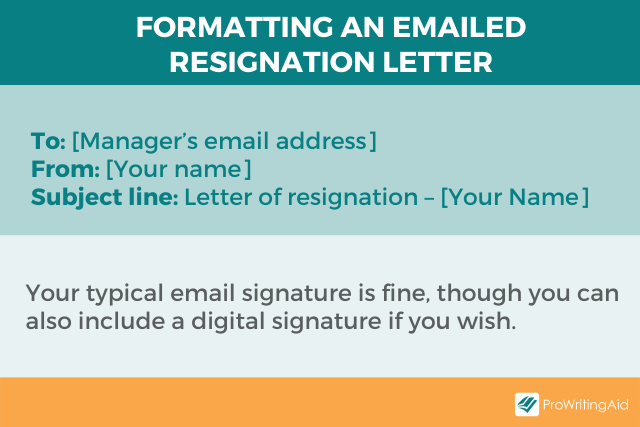
Should I Resign by Email or by Letter?
The best way to submit your resignation letter is in a private meeting with your manager. You can share your plans in person, and then hand them your formal letter to make sure it’s officially on record.
If you’re leaving on bad terms with your manager, you can also arrange an exit interview with a director or HR manager, where you can address any issues or concerns you have.
If an in-person meeting isn’t possible, you can also email your letter. A digital resignation letter should be written the same way as a physical resignation letter, but you don’t need the headers.
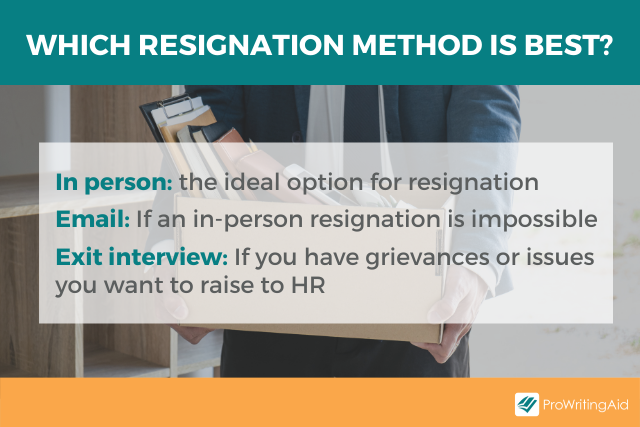
Do I Have to Give Two Weeks’ Notice Before Resigning?
Most companies in the U.S. require two weeks notice. That means you need to hand in your resignation letter at least ten business days before your departure date.
You should make sure to check the company handbook before you write your resignation letter, because for some companies, the notice period could be longer.
If you don’t give your two weeks' notice, you might lose any benefits you would have received from this company on leaving. For example, many companies pay out vacation days, and you might be forfeiting this payment by leaving without following the proper procedure.
Regardless, failing to give the proper notice may have a negative impact on the company as they scramble to fill your position last-minute, which means you’ll damage your reputation.
Failing to give two weeks’ notice could come back to bite you later in your career if you ever work with these colleagues again, or if you need to ask your boss for a reference.
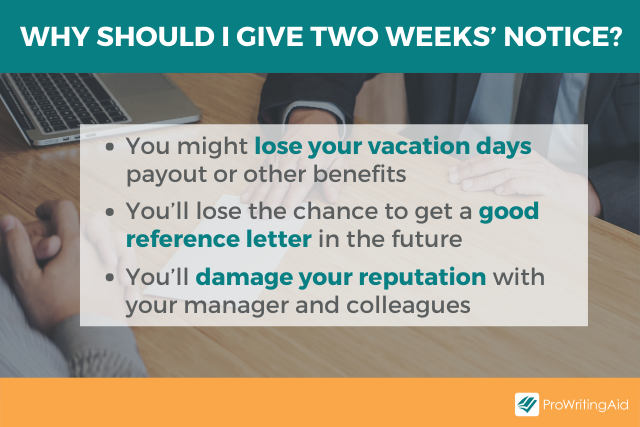
Whenever possible, try to follow the company policy and give your appropriate notice. It will help you in the long run.
How Do I Resign Gracefully?
Those are our tips for writing a successful resignation letter. The main thing to remember is to stay respectful, both by observing your company's notice period and by writing a letter that is clear, concise, and error free. We wish you luck with your job transition and the next stage of your career.


